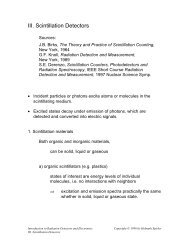Introduction to radiation-resistant semiconductor devices and circuits
Introduction to radiation-resistant semiconductor devices and circuits
Introduction to radiation-resistant semiconductor devices and circuits
You also want an ePaper? Increase the reach of your titles
YUMPU automatically turns print PDFs into web optimized ePapers that Google loves.
DET.<br />
PREAMP<br />
TEST INPUT<br />
GAIN/SHAPER COMPARATOR<br />
THRESHOLD<br />
ADJUST<br />
FIGURE 9. Block diagram of a readout channel for strip detec<strong>to</strong>rs.<br />
substantial circuit complexity would be necessary <strong>to</strong> maintain DC stability, so AC<br />
coupling is introduced at the input of the third stage. From here on the circuitry is<br />
differential. The third stage is still single-ended, but it is replicated as a dummy<br />
amplifier <strong>to</strong> bias the second input of the differential amplifier. The dummy amplifier<br />
is included in each individual channel <strong>to</strong> obtain optimal parameter tracking under<br />
<strong>radiation</strong> damage, <strong>and</strong> also <strong>to</strong> maintain a parallel architecture <strong>and</strong> reduce singlepoint<br />
failure modes. The threshold level is applied differentially <strong>to</strong> exploit device<br />
tracking during ir<strong>radiation</strong>.<br />
The design of CMOS logic circuitry does not offer the flexibility of selfadjusting<br />
circuitry. Since the threshold shifts of n <strong>and</strong> p MOSFETs are not complementary,<br />
circuit switching thresholds change. At high damage levels the device<br />
transconductance also suffers due <strong>to</strong> buildup of interface charge <strong>and</strong> increased<br />
scattering of charge carriers in the channel. Both effects change propagation<br />
delays, which can lead <strong>to</strong> race conditions (mismatches in propagation delays of<br />
streams whose results are combined) that cause circuit failure. These problems can<br />
be mitigated somewhat by careful design, but they point out a qualitative criterion<br />
for <strong>radiation</strong> <strong>resistant</strong> system design: complexity. As a general rule, simple logic<br />
circuitry can be made more <strong>radiation</strong> <strong>resistant</strong> than complex circuitry that requires<br />
relative control of many mixed serial <strong>and</strong> parallel paths. Fully clocked systems<br />
avoid this problem, but at substantial penalties in power, speed, <strong>and</strong> area. Careful<br />
consideration should be given before incorporating complete wish-lists of circuitry<br />
(on-chip digitization, digital signal processing, microprocessor controlled readout,<br />
etc.) in a severe <strong>radiation</strong> environment (apart from common-sensical considerations<br />
such as reliability <strong>and</strong> maintenance of components that are not accessible<br />
without major disassembly). Simplest tends <strong>to</strong> be best.<br />
25<br />
OUTPUT





